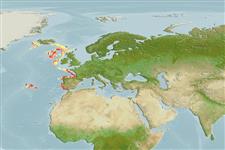Lớp phụ Cá sụn (cá mập và cá đuối) (sharks and rays) >
Rajiformes (Skates and rays) >
Rajidae (Skates)
Etymology: Neoraja: Greek, neos = new + Latin, raja = fish, Raja sp. (Ref. 45335); iberica: Named for its type locality, a very restricted area of the eastern North Atlantic along SW slope of the Iberian Peninsula, in both the Portuguese and Spanish sectors..
Environment: milieu / climate zone / depth range / distribution range
Sinh thái học
Biển Tầng đáy biển sâu; Mức độ sâu 270 - 784 m (Ref. 106604). Subtropical
Northeastern Atlantic: Iberian Peninsula, Spain and Portugal.
Length at first maturity / Bộ gần gũi / Khối lượng (Trọng lượng) / Age
Maturity: Lm 28.5, range 28 - 29 cm
Max length : 35.0 cm TL con đực/không giới tính; (Ref. 106604); 31.6 cm TL (female)
Short description
Hình thái học | Sinh trắc học
This species is distinguished by the following characteristics: ochre to greyish brown or dark greyish disc and posterior pelvic lobes distinctly ornamented dorsally by many dark brown spots and dots and usually a few paired whitish spots in small and half-grown specimens, all often reduced in larger specimens to few pairs if larger symmetrically placed brown, pale edged spots, plus 1-2 pairs of pale spots or dots; disc inverse heart-shaped with snout tip with short, triangular projections; length of tail about 62% (mean) of TL; lateral folds only along the posterior half or 1/3 of tail length; hypocordal lobe on caudal fin; anterior pelvic lobes about 3/4 of posterior lobe length; no nasobasal fenestrae on cranium, with narrow anterior fontanelle and delicate, thin rostral shaft almost reaching rostral node (Ref. 75590).
Life cycle and mating behavior
Chín muồi sinh dục | Sự tái sinh sản | Đẻ trứng | Các trứng | Sự sinh sản | Ấu trùng
Stehmann, M.F.W., B. Séret, E.M. Costa and J. Baro, 2008. Neoraja iberica n. sp., a new species of pygmy skate (Elasmobranchii, Rajidae) from the southern slope of the Iberian Peninsula (Eastern North Atlantic). Cybium 32(1):51-71. (Ref. 75590)
IUCN Red List Status (Ref. 130435)
Threat to humans
Harmless
Human uses
Thêm thông tin
Age/SizeSự sinh trưởngLength-weightLength-lengthLength-frequenciesSinh trắc họcHình thái họcẤu trùngSự biến động ấu trùngBổ xungSự phong phúBRUVS
Các tài liệu tham khảoNuôi trồng thủy sảnTổng quan nuôi trồng thủy sảnCác giốngDi truyềnElectrophoresesDi sảnCác bệnhChế biếnNutrientsMass conversion
Các công cụ
Special reports
Download XML
Các nguồn internet
Estimates based on models
Preferred temperature (Ref.
123201): 6.6 - 11.2, mean 9.9 °C (based on 24 cells).
Phylogenetic diversity index (Ref.
82804): PD
50 = 0.5312 [Uniqueness, from 0.5 = low to 2.0 = high].
Bayesian length-weight: a=0.00302 (0.00141 - 0.00645), b=3.24 (3.07 - 3.41), in cm total length, based on LWR estimates for this (Sub)family-body shape (Ref.
93245).
Mức dinh dưỡng (Ref.
69278): 3.6 ±0.6 se; based on size and trophs of closest relatives
Thích nghi nhanh (Ref.
120179): thấp, thời gian nhân đôi của chủng quần tối thiểu là 4.5 - 14 năm (Preliminary low fecundity).
Fishing Vulnerability (Ref.
59153): Low vulnerability (25 of 100).
Nutrients (Ref.
124155): Calcium = 22.2 [2.8, 390.2] mg/100g; Iron = 0.852 [0.081, 10.093] mg/100g; Protein = 16.3 [14.2, 18.3] %; Omega3 = 0.566 [0.237, 1.407] g/100g; Selenium = 28 [5, 143] μg/100g; VitaminA = 7.76 [0.62, 86.44] μg/100g; Zinc = 0.557 [0.036, 6.585] mg/100g (wet weight);
